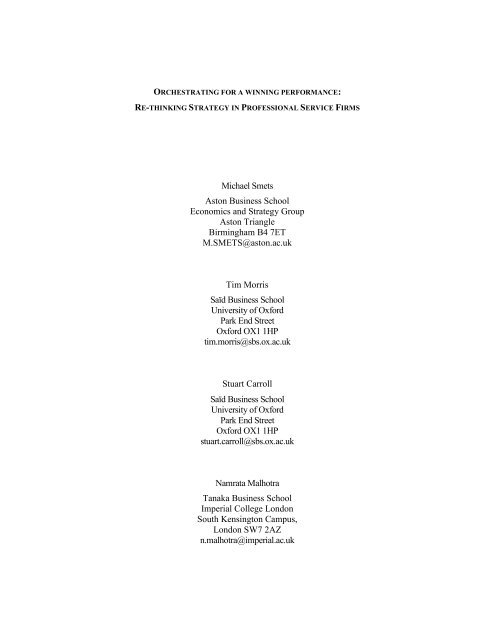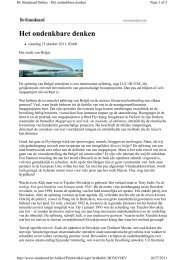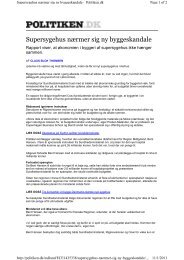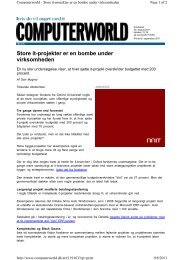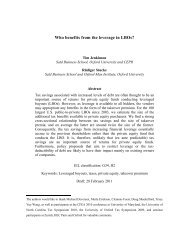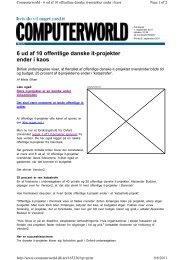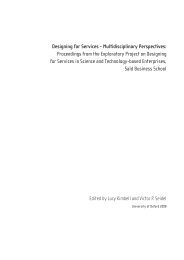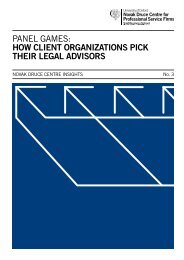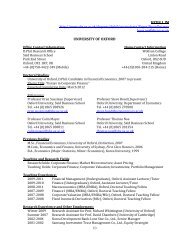Michael Smets Aston Business School Economics and Strategy ...
Michael Smets Aston Business School Economics and Strategy ...
Michael Smets Aston Business School Economics and Strategy ...
Create successful ePaper yourself
Turn your PDF publications into a flip-book with our unique Google optimized e-Paper software.
ORCHESTRATING FOR A WINNING PERFORMANCE:<br />
RE-THINKING STRATEGY IN PROFESSIONAL SERVICE FIRMS<br />
<strong>Michael</strong> <strong>Smets</strong><br />
<strong>Aston</strong> <strong>Business</strong> <strong>School</strong><br />
<strong>Economics</strong> <strong>and</strong> <strong>Strategy</strong> Group<br />
<strong>Aston</strong> Triangle<br />
Birmingham B4 7ET<br />
M.SMETS@aston.ac.uk<br />
Tim Morris<br />
Saïd <strong>Business</strong> <strong>School</strong><br />
University of Oxford<br />
Park End Street<br />
Oxford OX1 1HP<br />
tim.morris@sbs.ox.ac.uk<br />
Stuart Carroll<br />
Saïd <strong>Business</strong> <strong>School</strong><br />
University of Oxford<br />
Park End Street<br />
Oxford OX1 1HP<br />
stuart.carroll@sbs.ox.ac.uk<br />
Namrata Malhotra<br />
Tanaka <strong>Business</strong> <strong>School</strong><br />
Imperial College London<br />
South Kensington Campus,<br />
London SW7 2AZ<br />
n.malhotra@imperial.ac.uk
ORCHESTRATING FOR A WINNING PERFORMANCE:<br />
RE-THINKING STRATEGY IN PROFESSIONAL SERVICE FIRMS<br />
“Expert knowledge is the basis of success” has become a much-repeated mantra<br />
among professional service firm strategists. We think the idea that firms in<br />
accounting, law, consulting, engineering or advertising can exclusively or even<br />
primarily compete on the basis of their knowledge is outdated. It does not do justice to<br />
the competitive l<strong>and</strong>scape in general <strong>and</strong> to clients as discerning buyers of<br />
professional services in particular.<br />
We argue that most professional service firms (PSFs) cannot build competitive<br />
advantage on their expertise alone, but need a set of four interrelated resources:<br />
expertise, service, reputation <strong>and</strong> relationship. Individually, these form the necessary<br />
basis of a strong competitive position in the marketplace, albeit one that remains<br />
assailable. It is the combination <strong>and</strong> mutual reinforcement of these four resources that<br />
produces a truly winning performance. Professional service firms must orchestrate<br />
their resources so they feed off each other to occupy a market position that clients<br />
value <strong>and</strong> competitors cannot imitate. Orchestrating is the key to a winning<br />
performance.<br />
I. Competitive Advantage in Professional Service Firms<br />
<strong>Strategy</strong> in professional firms is beset with the mistaken assumption that concepts <strong>and</strong><br />
models developed for product-based organisations, from Kodak to Sony to BMW, can<br />
be applied to professional service firms. Take, for example, cost leadership, which<br />
may well offer some professional firms a form of advantage. However, the problem is<br />
that it is relevant only to certain services where scale <strong>and</strong> commoditisation rule. In<br />
most areas of professional service, the benefits of cost minimisation do not lead to<br />
competitive advantage. While cost control is an important issue for PSFs, this is<br />
different from arguing that being the lowest cost producer is a compelling strategic<br />
position for most firms.<br />
2
If cost leadership does not win clients, performance leadership must do so. In a<br />
service-based industry, a winning performance must rely on some form of valuable<br />
expertise, so the conventional wisdom about strategy in professional service firms<br />
says. The idea behind this expertise-focus is that professional firms compete in two<br />
related markets: one for clients <strong>and</strong> one for expert labour – professional staff.<br />
Professionals embody the expertise that their firms apply to produce valued solutions<br />
to client problems. In other words, expertise is the key input that PSFs use to produce<br />
their output, customised solutions to complex client problems. Maister differentiates<br />
three types of firm, based on the type of expertise they use to compete <strong>and</strong> the ways in<br />
which they organise <strong>and</strong> deploy it: The procedural firm deploys highly codified know-<br />
how to deliver relatively st<strong>and</strong>ardised solutions to well-established problems; the<br />
experience based firm draws on the ‘grey hair’ of its professionals, their experience<br />
with similar problems, to suggest solutions for ill-defined issues; <strong>and</strong> the expertise<br />
based firm competes on the great analytical horsepower of its professionals, building<br />
<strong>and</strong> using knowledge that offers bespoke, ‘rocket science’ solutions to tricky <strong>and</strong> new<br />
problems. Even though it comes in different forms, expertise is nonetheless the sole or<br />
at least dominant source of advantage in Maister’s view of PSFs. What drives their<br />
market strategy <strong>and</strong> competitive performance is the type of expertise they sell.<br />
The problem is that for most firms, their expertise, however broadly defined, is simply<br />
not something that distinguishes them <strong>and</strong> confers long-term competitive advantage.<br />
Their expertise is not unique in any substantial way <strong>and</strong> is susceptible to imitation or<br />
replication. Generally, the professional service marketplace is such that rivals either<br />
know what other firms know, or can develop expertise sufficiently easily, or can<br />
appropriate it from other sources to compete away any existing advantage. As<br />
expertise diffuses in the marketplace, it becomes increasingly commoditised <strong>and</strong> fails<br />
to justify premium fees.<br />
A small number of firms may lay claim to unique knowledge, but they are few <strong>and</strong> far<br />
between <strong>and</strong> even they would find it very difficult to keep their expertise proprietary<br />
<strong>and</strong> sustain a competitive position solely based on their know-how. This is simply<br />
because for PSFs, knowledge is both input <strong>and</strong> output. Its diffusion among clients <strong>and</strong><br />
competitors is an integral part of their business. Strategies for manufacturing<br />
3
usinesses warn that competitors can re-engineer the technology <strong>and</strong> knowledge<br />
embodied in tangible products <strong>and</strong> turn them into ‘me-too’ products, but traditional<br />
PSF strategies seem to overlook that the same may to some extent be true for the<br />
expertise underpinning professional services. For example, the legal expertise, market<br />
knowledge <strong>and</strong> commercial judgement that lawyers invest in designing a sophisticated<br />
financing structure, become known to a whole syndicate of banks buying into the<br />
structure <strong>and</strong> to their lawyers.<br />
At the same time, think about clients. The extent to which expertise can confer<br />
competitive advantage depends not just on whether competitors have what you have,<br />
but also whether clients need what you have. Many views on the value of professional<br />
expertise go back to the days when clients sought advice to cope with problems<br />
beyond their comprehension. Doctors treating patients, accountants assisting with<br />
family finance <strong>and</strong> solicitors advising on the status of the law are classic examples.<br />
However, these classic examples no longer reflect the reality of today’s professional<br />
service firms serving sophisticated institutional clients who wield substantial expertise<br />
themselves. Management consultants regularly face clients with substantial<br />
management knowledge <strong>and</strong> experience, because they are themselves managers, or –<br />
often enough – former management consultants. Corporate law firms advise banks<br />
whose in-house legal departments match mid-sized law firms in size, <strong>and</strong> whose<br />
members may well be recruited from these firms, <strong>and</strong> individual lawyers may end up<br />
across the table from seasoned investment bankers whose legal, let alone market<br />
knowledge, may easily rival theirs.<br />
In this changed professional service l<strong>and</strong>scape the key question is to what extent<br />
professional expertise can be an effective differentiator. With clients raising the bar<br />
for what counts as valuable knowledge <strong>and</strong> competitors mounting a challenge as to<br />
how long knowledge remains proprietary, it seems unrealistic that professional<br />
expertise is the only, or even the best way to strategically differentiate a professional<br />
service firm. We argue that traditional notions of expertise must be broadened <strong>and</strong><br />
that, however broadly defined, expertise is a necessary, but by no means sufficient,<br />
basis for a truly winning performance.<br />
4
II. Beyond expertise<br />
So, how should we think about strategic advantages for professional service firms?<br />
The best starting point is to look beyond expertise <strong>and</strong> recognize four pillars on which<br />
firms can build competitive advantage. These are expert knowledge, services,<br />
reputation <strong>and</strong> relationships. Individually, they may translate into a temporary<br />
competitive advantage, but, if skilfully combined, they jointly provide a basis for a<br />
winning performance <strong>and</strong> lasting success.<br />
Product<br />
Process<br />
Engagement<br />
Expertise<br />
Technical Knowledge<br />
Know How<br />
Experience<br />
Expertise<br />
Service Relationship<br />
Reputation<br />
Expertise<br />
Experience<br />
Engagement<br />
Current Clients<br />
Potential Clients<br />
Other Constituents<br />
Expertise is the first necessary resource, which – as discussed above – has received<br />
wide-ranging attention. By definition, expert knowledge held by individuals or groups<br />
within the firm forms the basic input of its services. This expertise may come in one<br />
of three forms. Firstly, some expertise is technical, like management concepts, legal<br />
norms, or laws of mechanics. Some of this ‘know-what’ may be codified in<br />
precedents, methodologies or models, while other parts are ‘personalised’ <strong>and</strong><br />
embodied in individuals, but not written down. Secondly, ‘know-how’ is less content<br />
based, but procedural, including communication, negotiation, or project management<br />
skills. Both types are commonly used interactively in most professional work as<br />
technical expertise is put to use. However, thirdly, in most cases clients do not want<br />
novel solutions or unique knowledge. They want a professional to demonstrate<br />
familiarity with their problem. They seek competence as demonstrated through<br />
5
experience. And they frequently know that there may be many providers who fit that<br />
category, the best of which they seek to identify using criteria other than expertise.<br />
Thus, on its own, expertise is rarely the route to success.<br />
Service<br />
Expertise is only of use to clients <strong>and</strong> PSFs to the extent that it translates into service.<br />
Service is more than the simple delivery of a knowledge product. It encompasses a<br />
process of implementation <strong>and</strong> a strong element of social engagement. The success of<br />
professional advice undoubtedly depends on the quality of the product that<br />
encapsulates the firm’s expertise, but it also depends on the processes in place to<br />
define, analyze <strong>and</strong> address client problems. Moreover, effective delivery <strong>and</strong><br />
implementation depend on the professionals’ skills of working with, instead of merely<br />
for, a client. The ability to engage with clients at an intellectual <strong>and</strong> social level can<br />
enhance information exchange, reduce tensions <strong>and</strong> make eventual crises appear more<br />
manageable. The “feel” of the transaction is often considered as distinctive a service<br />
feature as the quality of the product <strong>and</strong> the efficiency of its delivery process.<br />
Reputation<br />
Reputation is the third necessary resource on which PSFs can compete. Reputation<br />
signals to clients <strong>and</strong> others, such as potential employees, about the characteristics of<br />
the firm. It is important because the intangible <strong>and</strong> complex nature of the products of<br />
professional firms means that their quality is difficult to sample before purchase.<br />
What buyers can easily sample is previous clients’ quality assessments as they<br />
coalesce in the firm’s reputation, reflecting a firm’s successful track-record in the<br />
marketplace. It translates the competence displayed in one specific instance into a<br />
perceived general capability that can be replicated or applied to other contiguous<br />
problems. Reputation is therefore a necessary signal of competence which firms have<br />
to develop over time in order to survive.<br />
As a first step to move from mere survival to creating a winning performance, PSFs<br />
must develop a broader awareness of their reputation. Because services not only<br />
comprise product, but also process <strong>and</strong> social elements, PSFs must try to build a<br />
distinctive reputation in all of these areas. Clients rarely choose their advisers<br />
exclusively based on the perceived excellence of their product, especially when<br />
6
products are easily imitated <strong>and</strong> comparable amongst competitors. Clients often care<br />
about the how as much as about the what of service delivery. They are concerned with<br />
how quickly results can be achieved, how efficiently service delivery can be managed,<br />
<strong>and</strong> how engaged advisers are in achieving results together with their clients.<br />
Imagine being at the receiving end of technically excellent legal advice that comes<br />
along as an academic treatise with minimum application to your situation. Or think of<br />
a banking lawyer who designs a sophisticated financial structure for you, but fails to<br />
have all documents signed by the right people by the right time. Professional advisers<br />
are often called when big bets are at stake <strong>and</strong> clients <strong>and</strong> advisers are forced to<br />
“spend the night” <strong>and</strong> resolve the most pressing issues. In all these situations, a<br />
reputation for sheer excellence is unlikely to win the PSF the deal. Instead,<br />
reputations for down-to-earth applied advice, for the ability to project-manage <strong>and</strong> get<br />
things done, or for being “good people” who underst<strong>and</strong> the clients’ concerns <strong>and</strong> are<br />
fun to work with even when crunchtime comes, may sway clients in the firm’s favour,<br />
because technical competence is taken as a given. In a professional service l<strong>and</strong>scape<br />
where a differentiation on sheer technical grounds is difficult to establish <strong>and</strong> losing<br />
importance in clients’ decision-making, ignoring those additional reputations puts any<br />
PSF at risk.<br />
Even with this broad view, though, reputation on its own remains insufficient to<br />
provide any sustainable advantage. Reputation does little to nothing for performance<br />
unless it is put to use to build relationships. Reputation provides the means to create<br />
lucrative relationships with clients <strong>and</strong> with gatekeepers who can open up market<br />
opportunities. The fourth necessary condition for professional firms to prosper is to<br />
build on expertise, services, <strong>and</strong> reputation to establish <strong>and</strong> extend their relationships.<br />
Relationship<br />
Relationships are usually started after the parties have made some estimate of<br />
advisers’ competence <strong>and</strong> experience based on their track record. Over time, they<br />
enable clients <strong>and</strong> others to build familiarity <strong>and</strong> trust in each other’s intentions <strong>and</strong><br />
competence. They create value by providing clients <strong>and</strong> advisers with opportunities<br />
for learning <strong>and</strong> adjustment that make future interactions more efficient.<br />
Simultaneously, from the PSF’s perspective, entrenched relationships raise switching<br />
7
costs in terms of time, money <strong>and</strong> risk, increasing the likelihood of repeat custom with<br />
longst<strong>and</strong>ing clients. In other words, expertise <strong>and</strong> reputation facilitate the building of<br />
relationships; in turn, the experience <strong>and</strong> deep client knowledge gained from<br />
relationships provides opportunities for refreshing or developing expertise.<br />
III. Orchestrating as capstone capability<br />
Firms should think of expert knowledge as a foundation stone of competitive<br />
advantage in conjunction with services, reputation <strong>and</strong> relationships. Individually,<br />
each of these resources is assailable <strong>and</strong> for most firms most of the time, their<br />
knowledge, reputation <strong>and</strong> relationships can be matched, appropriated or imitated.<br />
However, things change if expertise is strategically viewed not just as a resource in its<br />
own right, but as starting point of a cycle, in which knowledge permits the<br />
development of services, the creation of reputation <strong>and</strong> the forming of lasting<br />
relationships. Firms that underst<strong>and</strong> the inter-connectedness of their resources must<br />
reflect this in their strategy. Like instruments in a music ensemble, expertise, services,<br />
reputation <strong>and</strong> relationships must be orchestrated to get the maximum effect from<br />
each one. In modern PSFs, orchestrating is the capstone capability that transforms<br />
expertise, services, reputation <strong>and</strong> relationships into a set of inter-connected<br />
resources, creating a sustainable competitive position.<br />
Product<br />
Process<br />
Engagement<br />
Technical Knowledge<br />
Know How<br />
Experience<br />
Expertise<br />
Service Orchestrating<br />
Relationship<br />
Reputation<br />
Expertise<br />
Experience<br />
Engagement<br />
Current Clients<br />
Potential Clients<br />
Other Constituents<br />
8
Orchestrating acts as the central driver of competitive advantage where it is not<br />
simply taken as coordinating isolated resources, but connecting them in a dynamic<br />
process. A well-orchestrated firm naturally sets in motion a creative swirl that<br />
continuously updates each resource <strong>and</strong> rejuvenates the firm as a whole. Advisers<br />
apply organizational <strong>and</strong> individual expertise to design <strong>and</strong> deliver their service,<br />
adding another line to the firm’s track-record <strong>and</strong> building its reputation. A<br />
continuously reinforced reputation protects the firm from being seen to live on past<br />
glories <strong>and</strong> allows it to develop relationships with current <strong>and</strong> potential clients, as well<br />
as other gatekeepers. The learning opportunities that arise within these relationships<br />
then allow the PSF to update <strong>and</strong> refine its expertise, starting another cycle. The<br />
“faster” the swirl spins, the more quickly resources are updated <strong>and</strong> developed,<br />
helping the firm to stay ahead or at least abreast of a chasing market.<br />
To make sure this creative swirl stays in motion, PSFs should not rely on the natural<br />
dynamics between expertise, services, reputation <strong>and</strong> relationships, but actively<br />
orchestrate them to maximize competitive advantage. Therefore it is important to<br />
underst<strong>and</strong> what it takes to create a well-orchestrated organization.<br />
IV. How to orchestrate successfully<br />
In every quadrant of the cycle, PSFs can institutionalize practices that give the swirl<br />
new momentum. The firms building sustainable competitive advantage are those that<br />
are templating, communicating, associating <strong>and</strong> innovating.<br />
Product<br />
Process<br />
Engagement<br />
Technical Knowledge<br />
Know How<br />
Experience<br />
Expertise<br />
Templating Innovating<br />
Service Orchestrating Relationship<br />
Communicating Associating<br />
Reputation<br />
Expertise<br />
Experience<br />
Engagement<br />
Current Clients<br />
Potential Clients<br />
Other Constituents<br />
9
Templating<br />
Templating involves any activity to make explicit or codify the firm’s expertise for<br />
accurate <strong>and</strong> quick application in service delivery. Much of a firm’s expertise,<br />
especially in PSFs, is developed <strong>and</strong> held by individual professionals. The technical<br />
knowledge they bring from their training as well as the experience <strong>and</strong> know how<br />
they build at work must be made widely accessible to maximize its effect on the<br />
firm’s bottom-line <strong>and</strong> its long-term competitive position. While the commodification<br />
of knowledge in the marketplace is the firm’s nemesis, internal templating may be its<br />
salvation. This is not to suggest that any expertise should be st<strong>and</strong>ardized <strong>and</strong> the firm<br />
should try to compete on cookie-cutter solutions. However, the basis from which<br />
highly customized solutions are developed can be strengthened so that innovative<br />
services can be rolled out more accurately <strong>and</strong> quickly to a larger population of<br />
clients. Templating allows PSFs to appropriate a larger share of the market, solve any<br />
teething troubles, build a reputation for the specific product <strong>and</strong> cash in before<br />
competitors catch up with re-engineered ‘me-too’ service offerings. For example,<br />
consultants or accountants can make explicit the methodologies by which client<br />
problems are defined, analyzed <strong>and</strong> addressed, speeding up the delivery process. A<br />
banking lawyer can design a bespoke financial product for one client, but then take a<br />
step back, codify its basic mechanisms in a template document that colleagues can<br />
leverage to offer their clients similar products within much shorter deadlines. In sum,<br />
templating enhances the speed, consistency <strong>and</strong> reliability of service delivery <strong>and</strong><br />
allows the firm to exploit its expertise more exhaustively before competitors catch up.<br />
Communicating<br />
Professionals delivering their services naturally leave a track-record for their<br />
experience <strong>and</strong> expertise. However, this record is mostly contained among those who<br />
experience the service; that is, clients <strong>and</strong> possibly other service providers involved in<br />
the project. While word of mouth or media coverage may carry their perceptions into<br />
the market, they primarily reflect individual rather than organizational capabilities<br />
<strong>and</strong>, hence, not what professional firms want to rely on for strategically developing<br />
their reputation. Instead, they want to thrive on a reputation that signals existing<br />
organizational capabilities <strong>and</strong> how they can be leveraged in future work for existing<br />
<strong>and</strong> new clients.<br />
10
Firms must focus on strategically training track-record into a corporate reputation.<br />
They must be communicating. This involves the definition <strong>and</strong> transmission of<br />
information <strong>and</strong> image to a network of clients, potential clients <strong>and</strong> other gatekeepers<br />
who can make favourable judgements about the firm’s competencies <strong>and</strong> how they<br />
translate into future services. Reputation-focused communicating does not pitch for a<br />
specific project or market specific services, but focuses on translating individual<br />
track-record into a perceived general capability. In practice, communicating exceeds<br />
traditional marketing <strong>and</strong> advertising to include website pages <strong>and</strong> client newsletters,<br />
but also seminars, conferences, speeches <strong>and</strong> published articles. While it is essential<br />
to occupy specific topics of concern to clients, it is also critical to communicate about<br />
all aspects of reputation, focused around products, processes <strong>and</strong> service experience.<br />
Associating<br />
Reputation by itself, however, does not add to the bottom-line. It only impacts the<br />
firm <strong>and</strong> its competitive position if it is reflected in the firm’s relationships. Again,<br />
this transition is far from natural, but has to be strategically managed through a set of<br />
associating activities. Traditionally, this has been described as client relationship<br />
management, business development or, in more vernacular terms, client schmoozing.<br />
Associating is a more encompassing <strong>and</strong> integrated approach to relationship<br />
management, trying to forge a lasting link between advisers <strong>and</strong> clients as business<br />
associates. Firms aiming to associate clients approach the relationship <strong>and</strong> any<br />
activities to manage it with their reputation, expertise, <strong>and</strong> services in mind. This type<br />
of communicating can involve a plethora of activities to institutionalize or develop<br />
client relationships by providing learning opportunities <strong>and</strong> strengthening interfaces.<br />
Seconding professional staff to key clients is one example of associating, because it<br />
creates better underst<strong>and</strong>ing on both sides <strong>and</strong> facilitates future interactions. Other<br />
examples are client briefings on current industry trends <strong>and</strong> future scenarios or joint<br />
training. These communicating activities strengthen client relationships based on the<br />
firm’s reputation <strong>and</strong> expertise. Most importantly, they create added value, which may<br />
give the client an interest in maintaining the relationship.<br />
Innovating<br />
Finally, this dynamic process of continuous renewal comes full circle, when<br />
relationships are exploited to update existing expertise through innovating. Because<br />
11
expertise becomes commoditised <strong>and</strong> clients face new problems, innovating is vitally<br />
important for professional firms. Generally, clients sense the direction of incremental<br />
innovation, take themselves a leading role in it, or even initiate more radical change.<br />
In any case, they send signals to their advisory firms or individuals within them as to<br />
where <strong>and</strong> how to update their expertise. These signals, however, are mostly sent to –<br />
or picked up by – those advisers with longst<strong>and</strong>ing relationships. With them, clients<br />
may even engage in the co-production of new expertise. Therefore, innovating firms<br />
must maximize learning opportunities that yield new expertise which is valuable<br />
within the relationship from which it is created, but also beyond.<br />
Because of the importance of orchestrating for the creation of long-term competitive<br />
advantage, it is essential that in the process of orchestrating expertise, services,<br />
reputation <strong>and</strong> relationships, they are not managed individually, but in terms of each<br />
other. Managing each component on its own may temporarily move the firm ahead,<br />
but leave it vulnerable to competitors catching up. A firm that orchestrates its<br />
resources through the activities described above generates creative momentum that<br />
allows it to take the “next step”, as its competitors catch up with the previous one. As<br />
soon as this momentum is interrupted, because individuals in the firm focus on one<br />
resource to the neglect of others, st<strong>and</strong>still looms <strong>and</strong> competitors are given the<br />
chance to catch up.<br />
V. Orchestrating for a winning performance<br />
The biggest competitive potential of an orchestrating firm, however, does not lie in its<br />
ability to take the next step around the cycle, updating its existing expertise, services,<br />
reputation, <strong>and</strong> relationships, but in the ability to take a step “out of” the existing<br />
cycle <strong>and</strong> start a new one – from any given position in its current creative swirl. These<br />
“spin-offs” allow an orchestrating firm not only to run the same track as its<br />
competitors, just faster, but also to change tracks quickly <strong>and</strong> possibly run against<br />
fewer competitors for a while.<br />
12
New Product<br />
Product<br />
Process<br />
Engagement<br />
New Expertise<br />
Technical Knowledge<br />
Know How<br />
Experience<br />
Expertise<br />
Templating Innovating<br />
Service Orchestrating Relationship<br />
Communicating Associating<br />
Reputation<br />
Expertise<br />
Experience<br />
Engagement<br />
Templating not only facilitates the application of existing expertise in service<br />
delivery, but allows the creation of new products. Very different from expertise,<br />
templating recombines different knowledge components <strong>and</strong> packages them in a way<br />
that addresses existing client needs in a new way.<br />
New Market<br />
Communicating turns a service track record into reputation, but also creates new<br />
expertise, which can grow the market. As firms communicate their expertise,<br />
experience, <strong>and</strong> track record to external constituents, they also alert competitors to<br />
these capabilities <strong>and</strong>, in a sense, “educate” the market about cutting edge services.<br />
Given the concerns about imitation <strong>and</strong> commoditization, it seems paradoxical why<br />
any professional firm would want to educate a market that not only includes clients,<br />
but also competitors. The answer is that by spreading knowledge of innovations, firms<br />
can more quickly <strong>and</strong> efficiently develop a market. Take the example of the banking<br />
lawyer once again: A top firm designing a cutting edge financing structure for a<br />
borrower needs a competent counter-part to advise the bank to get the deal done.<br />
Dealing with an “uneducated” adviser who is unfamiliar with market practice is likely<br />
to raise unnecessary questions, delay negotiations <strong>and</strong> eventually jeopardize the deal.<br />
Thus, it is advantageous to educate the market, including competitors, because it<br />
grows the market <strong>and</strong>, by consequence, the value of the firm’s share within it.<br />
Current Clients<br />
Potential Clients<br />
Other Constituents<br />
New Client<br />
Associating translates reputation into relationships. Well managed, associating with<br />
current clients attracts new clients to the firm’s services <strong>and</strong> interests existing clients<br />
13
in new services. How did accounting firms grow? They used their reputation for<br />
excellent accounting services they enjoyed with existing clients <strong>and</strong> started to offer<br />
consulting services on top. Similarly, they poached tax advisory work from law firms,<br />
growing their business by associating more clients <strong>and</strong> more work from existing<br />
clients. New clients buying the firm’s services offer more opportunities to build track<br />
record <strong>and</strong> update expertise, starting a new creative swirl in its own right.<br />
Finally, innovating exploits relationships not only to update existing organizational<br />
expertise, but also to open new markets. New markets can be defined by product or<br />
region. Entrenched client relationships give professional firms a number of<br />
advantages. These can be leveraged when clients push their boundaries <strong>and</strong> decide to<br />
take along their advisers of choice. Internationalizing firms are likely to seek host<br />
country advice from their trusted advisers at home, rather than sampling local<br />
providers on such critical decisions. Global accounting <strong>and</strong> law firms are classic<br />
examples of professional firms following their clients around the globe <strong>and</strong><br />
continuously exp<strong>and</strong>ing their radius of action. Similarly, clients will consult their<br />
trusted advisers on novel problems <strong>and</strong> use them as sounding boards for new business<br />
ideas. In both cases, they ask their advisers not only to update existing expertise, but<br />
to develop radically new knowledge <strong>and</strong> push the frontiers of their profession. In this<br />
sense, close, longst<strong>and</strong>ing client relationships are not just critical for securing repeat<br />
business <strong>and</strong> updating existing expertise, but are the entry ticket to move the firm<br />
beyond its existing boundaries. As no two professional firms share identical histories<br />
with the same client, their relationships are unique, as are the opportunities for<br />
innovation that flow from them.<br />
To summarize, orchestrating is the capstone capability of the modern professional<br />
service firm. It ensures that current expertise is constantly updated <strong>and</strong> periodically<br />
revolutionized. Without this dynamism expertise atrophies <strong>and</strong> effectively sends firms<br />
backwards in a chasing market. Like expertise, reputation has been assumed to be a<br />
basis of competitive advantage, but only good for a while. While both are necessary,<br />
they are by no means sufficient ingredients of lasting competitive advantage. This<br />
ultimately rests on the orchestration of the firm’s expertise, services, reputation <strong>and</strong><br />
relationships. Continuous inter-linkage <strong>and</strong> renewal of these resources ensures the<br />
firm moves with the market – <strong>and</strong> ahead of it.<br />
14


